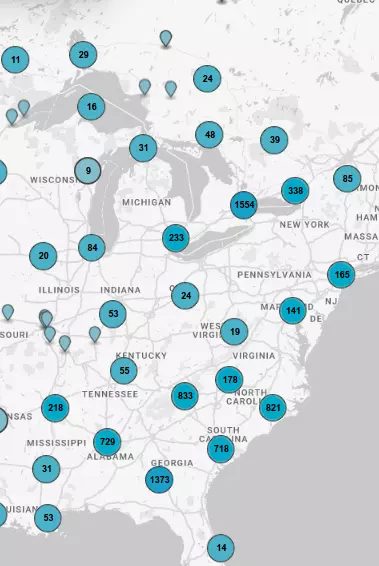The Founding of Bothwell, 1855
In 1851 George Brown, founder of the Toronto Globe and one of Canada's Fathers of Confederation, purchased about 1620 ha in this vicinity. The Great Western Railway ran through his property...
- toronto
- ontario
- alan brown
Fort Frontenac
Here stood Fort Cataraqui or Frontenac built by Count de Frontenac in July, 1673, and rebuilt by La Salle in 1675. For many years the key to the West, the base of La Salle's explorations and...
- toronto
- ontario
- alan brown
The Founding of Midland
In 1871 a group of the principal shareholders of the Midland Railway, headed by Adolph Hugel, selected this location as the northern terminus of their line which then ran from Port Hope...
- toronto
- ontario
- alan brown
The Founding of Brampton
Chinguacousy Township, part of the Mississauga Indian tract, was surveyed in 1819. John Elliott, John Scott and William Buffy were early settlers here of a crossroads hamlet first known as...
- toronto
- ontario
- alan brown
Fort Henry
The first Fort Henry was built during the War of 1812 to protect the British dockyards in Navy Bay. The present limestone citadel, constructed between 1832 and 1837, replaced the old fort as part...
- toronto
- ontario
- alan brown
The French Presence in Lafontaine
French explorers first arrived in the Lafontaine area around 1610. An intermittent French presence of fur traders, soldiers and missionaries continued until 1650 when the sojourns ended after the...
- toronto
- ontario
- alan brown
French Settlement on the South Shore
Windsor is the oldest known site of continuous settlement in Ontario. The government of New France, anxious to increase its presence on the Detroit River, offered land for agricultural settlement...
- toronto
- ontario
- alan brown
The Founding of Springfield
About 1850, some ten years after this area was settled, a school and a Methodist meeting house were erected here on the town line between the Townships of South Dorchester and Malahide. Shortly...
- toronto
- ontario
- alan brown
The French Presence in Hearst
French Canadians began to settle in Hearst in 1912 during the construction of the National Transcontinental Railway. Most came to farm but soon turned to the more lucrative forest...
- toronto
- ontario
- alan brown
Forsyth's Raid 1813
On the night of February 6-7, 1813, Major Benjamin Forsyth of the United States Army, with a detachment of regulars and militia numbering about 200 men, crossed the frozen St. Lawrence River from...
- toronto
- ontario
- alan brown
The Founding of Markham
The earliest settlers in this part of Markham Township, including several "Pennsylvania Dutch", arrived on the Rouge River shortly after 1800. Within ten years Nicholas Miller had erected...
- toronto
- ontario
- alan brown
Founding of Red Lake Mining District
In 1924, two years after a discovery of gold by Gus McManus, the Ontario Department of Mines published a geological report on this district. Prospecting was thus encouraged and in 1925 claims were...
- toronto
- ontario
- alan brown
Founding of Haliburton
The Canadian Land and Emigration Company of London, England, was incorporated in 1861 and purchased for settlement purposes in this region, nine adjoining wilderness townships comprising some...
- toronto
- ontario
- alan brown
The Founding of Dunnville
The construction of a dam and canal designed to feed water from the Grand River to the new Welland Canal fostered the development of a settlement here during the late 1820s. A town plot,...
- toronto
- ontario
- alan brown
The Founding of Owen Sound
In November, 1840, a townplot in Sydenham Township was surveyed as the terminus of the Garafraxa- Owen's Sound Road. John Telfer, government agent, completed his house by November 21 and a...
- toronto
- ontario
- alan brown
The Founding of Aylmer
In October 1817, John Van Patter, an emigrant from New York State, obtained 80 ha of land and became the first settler on the site of Aylmer. During the 1830's a general store was opened and...
- toronto
- ontario
- alan brown
The Founding of Bayfield
In 1832 Carel Lodewijk, Baron van Tuyll van Serooskerken, a Dutch nobleman, purchased large holdings in the Huron Tract including 157 ha here which he set aside for a settlement. During the next...
- toronto
- ontario
- alan brown
Founding of Englehart
Englehart owes its beginnings to the Temiskaming and Northern Ontario Railway (T. & N.O.), a colonization line designed by the provincial government to open agricultural lands of the Little Clay...
- toronto
- ontario
- alan brown
Founding of Port Hope
Peter Smith, a fur trader, occupied a house here at "Smith's Creek" in 1788. The first permanent settlers were Loyalists brought to the Township in 1793 by a group of associates headed by...
- toronto
- ontario
- alan brown
The Founding of Thorold
During the construction of the original Welland Canal, 1824-1829, a number of communities sprung up along its length. Here, on land belonging to George Keefer, a village known as Thorold...
- toronto
- ontario
- alan brown
